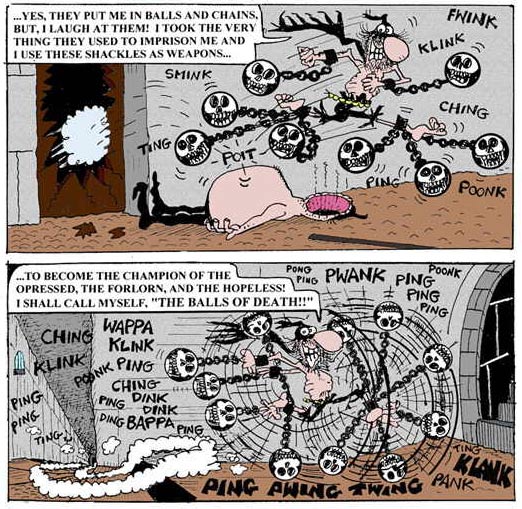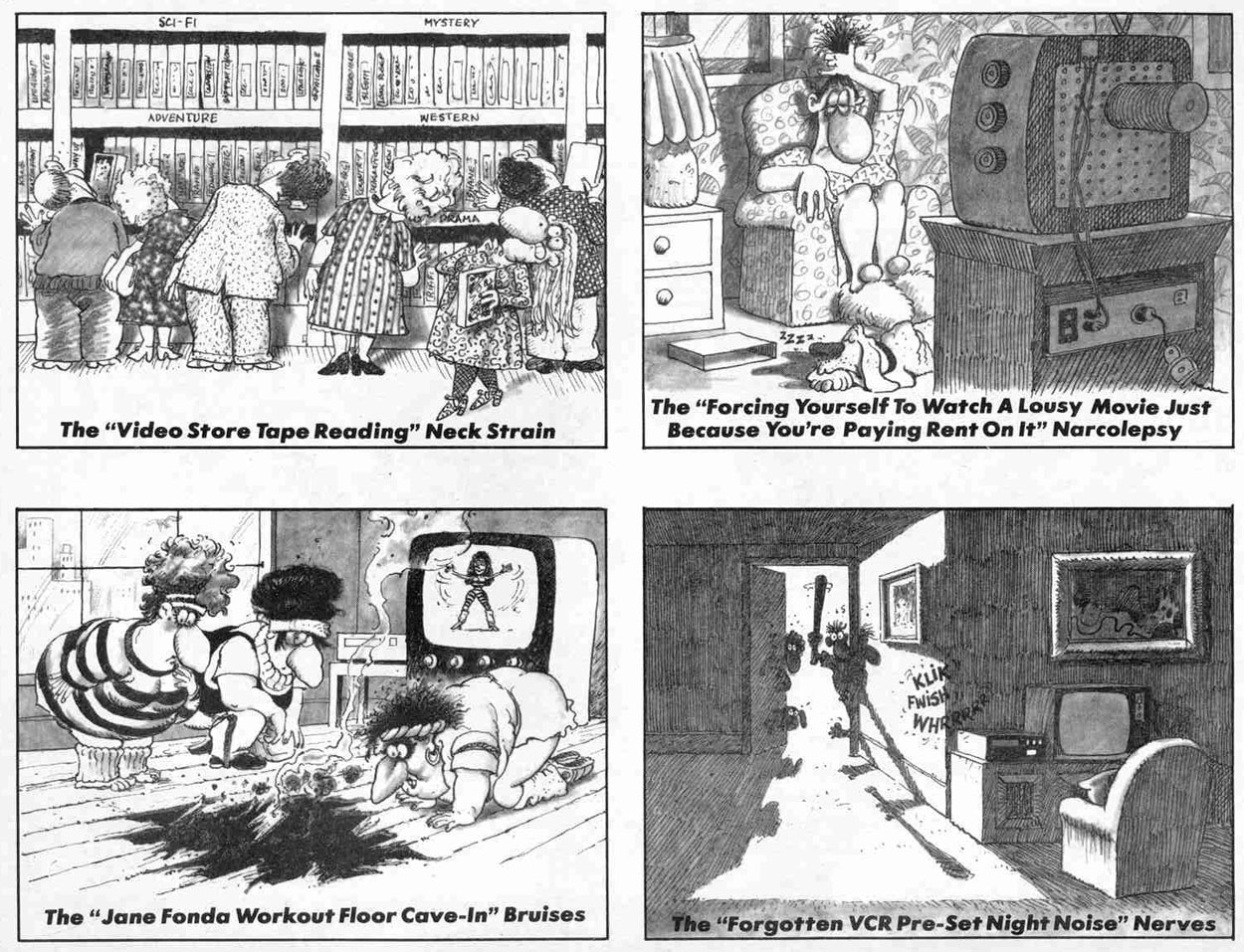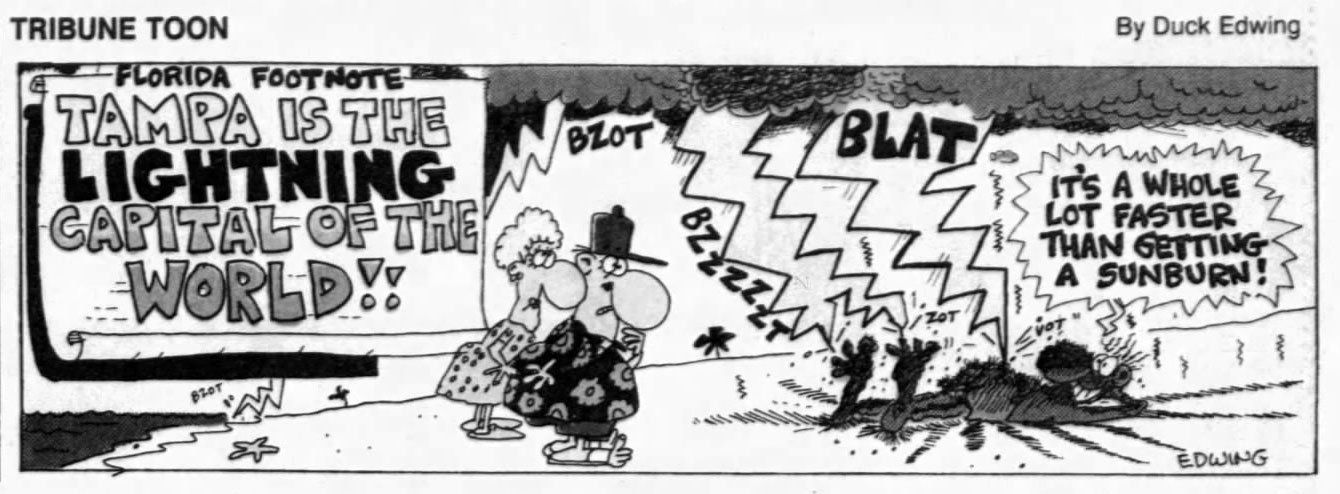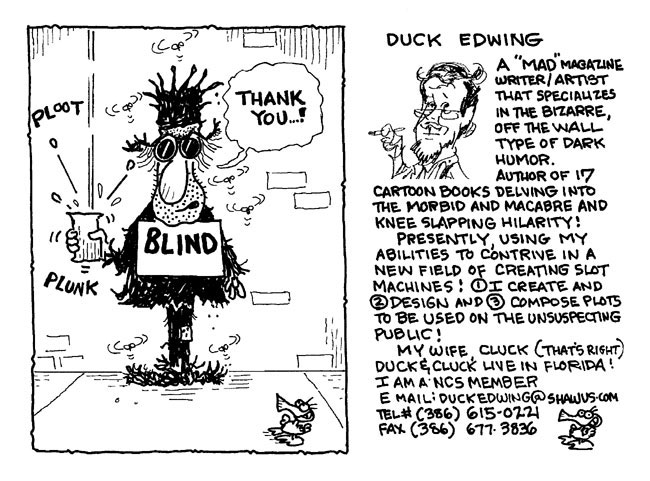'The Balls of Death'.
Don Edwing, nicknamed "Duck" Edwing, was one of Mad magazine's "usual gang of idiots". Both as a writer and as an illustrator, he worked for the magazine for half a century, from 1962 until 2012. He wrote gags for Don Martin and, between 1987 and 2007, for the 'Spy vs. Spy' feature. His own gag comics are recognizable for their bulbous-nosed characters and black comedy. Outside of Mad, Edwing was a scriptwriter for the newspaper gag comics 'Lancelot' by Frank Ridgeway and Paul Coker (1970-1972), 'Horace and Buggy' with Paul Coker (1971) and Bob Thaves' 'Frank and Ernest'. For the Swedish magazine Herman Hedning, Edwing created the gag comics 'The Balls of Death', 'Super Sock' and 'The Super Family', and he also wrote and drew the gag strip, 'Tribune Toon' (1993-1996), in The Tampa Tribune. Despite his long career, Edwing has remained somewhat of an unsung hero. Most of his work was done as an anonymous scriptwriter and his own graphic career started later in life, from 1975 on. Still, his work is fondly remembered by any longtime Mad reader between the 1980s and 2010s.
Early life and career
Donald Ray Edwing was born in 1934 in Jersey City, New Jersey. Like many cartoonists, he enjoyed drawing as a child, devouring every comic book he could get his hands on and watching every Warner Bros. cartoon. He ranked Don Martin and Alex Ross as his favorite comic artists, and cited 'Sherlock Holmes' author Arthur Conan Doyle as his favorite novelist. Edwing briefly served in the U.S. Navy, but eventually entered into the comics industry. While in art school in New York, he published his first cartoon in Harvey Kurtzman's short-lived magazine Help! (1960-1965). Other gag cartoons he created ran in Look, The Saturday Evening Post and Hugh Hefner's Playboy.
Edwing used the name "duck" as his pseudonym and often drew a tiny duck in the final panel of his cartoons. Continuing the joke, he also nicknamed his wife Claire "Cluck". The artist often gave different explanations why he picked out this particular waterfowl. Since his full name is "Donald", he sometimes claimed it was a nod to Donald Duck. Other times he pointed to his favorite comedians The Marx Brothers, their iconic "Why a Duck?" comedy routine in the film 'The Cocoanuts' (1929) and their movie 'Duck Soup' (1933). However, Edwing also said that ducks are simply inherently funny animals. Interviewed in Mad XL#20 (March 2003), he revealed that one time he and Al Jaffee were sitting in an outdoor café in Europe, when Jaffee said: "I've come to the conclusion that 'duck edwing' is a verb." In a 23 February 1998 interview with Florida Today, he said he chose a pseudonym to avoid confusion with his Mad colleague Don Martin.
'Video Maladies', Mad #265 (September 1986), a satire of home videos, scripted and written by Edwing and drawn in collaboration with Harry North .
Mad Magazine
In April 1962, Edwing debuted in Mad's 70th issue. He was a mainstay for five decades, even though the majority of his work was done as a writer, rather than a comic artist. He penned gags, ideas, stories and articles for many of Mad's regular illustrators. From issue #157 (March 1973) on, Edwing wrote many advertisements for subscriptions to Mad, usually under the title "Why KILL yourself... just because you missed the latest issue of Mad?" The cartoons typically featured people attempting suicide in far-fetched and humorous ways, like dressing up as a banana and then entering an ape cage.
'Three Days of the Condom' (Mad #366, February 1998).
1975 proved to be a turning point in Edwing's career. In July of that year he drew his first comic strip for the magazine, 'A Mad Look at Sea Burials', which appeared in its 176th issue. One issue later, he also started a collaboration with Mad's "maddest" artist, Don Martin, for whom he wrote many of his most classic gags. Martin had a strong impact on Edwing's own comics, both in goofy characters, odd onomatopoeia, mad situations and his one-page gag format. By the time Martin left Mad in 1988 over a pay dispute, Edwing was his natural successor. On occasion, Edwing has also illustrated scripts by Frank Jacobs.
Spy vs. Spy
In 1987, Duck Edwing emerged as the new scriptwriter for Mad's long-running pantomime gag comic 'Spy vs. Spy', after the original artist Antonio Prohias retired. Edwing left the artwork to new artists like Bob Clarke, Dave Manak and Peter Kuper. With Manak, he also made a 'Spy vs. Spy' Sunday comic, which ran for 39 weeks through Tribune Media Services in 2002. Edwing continued writing for 'Spy for Spy' in Mad Magazine until 2007.
'A Rascally Religious Ruse' (Mad #328, June 1994).
Tales From the Duck Side and other features
From the 1980s on, the amount of Duck Edwing cartoons in Mad increased, especially when they ran under the header 'Tales From the Duck Side'. Starting with issue #443 (July 2004), Edwing became a regular gag artist for Mad's Fundalini pages, where his contributions eventually received the subtitle 'Duck Droppings' from issue #463 (March 2006) on. He had used this pun for the first time in issue #417 (May 2002).
Edwing's comics had few recurring characters. One exception was the Ventriloquist Priest, who fools churchgoers by acting as if God or some religious statue spoke to them. Between issue #353 (January 1997) and #376 (December 1998), Mad irregularly featured Edwing's 'The Masked Mountie and His Wonder Dog Biscuit'. The masked crusader always came up with a plot to defeat the villain of the week, but usually ended up dismembering himself or suffering other painful torture. Otherwise, most of Edwing's characters were nameless, identical-looking chubby little men and women with big round noses. Recurring themes were gags about human-devouring monsters, cannibals, blind people, torture chambers and executioners. Apart from these black comedy topics, Edwing also loved ridiculing superheroes.
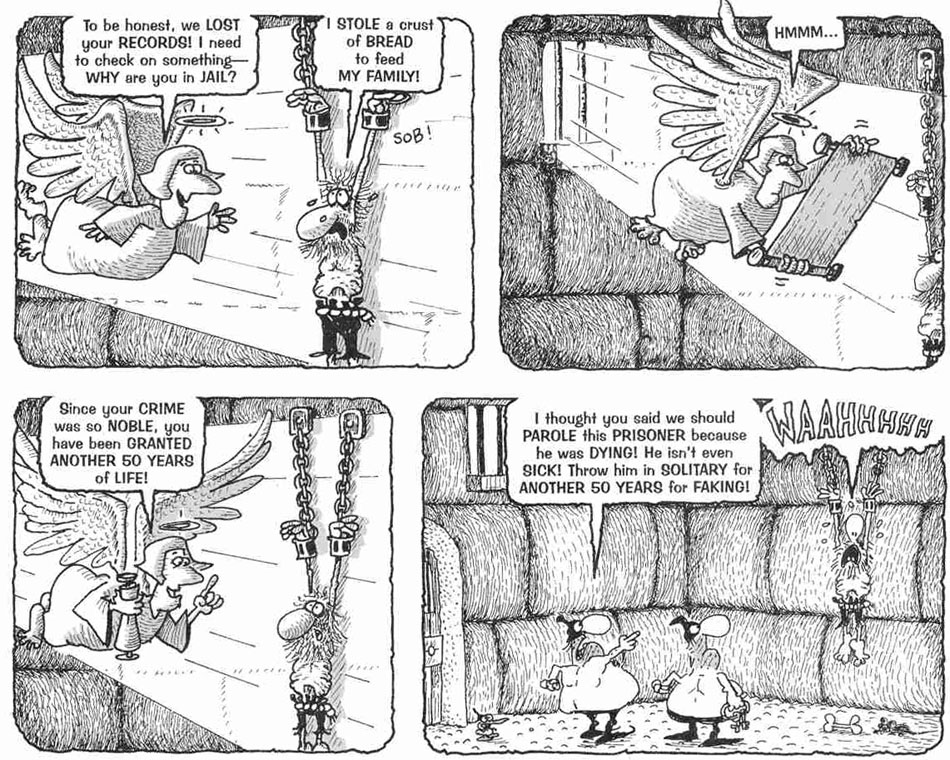
Mad books
Edwing's work was collected in several paperbacks, namely 'Don Edwing's Mad Bizarre Bazaar' (1980, with a foreword by his mentor Don Martin), 'Mad Book of Almost Superheroes' (1982), 'Mad Variations' (1984), 'Don Edwing's Mad's Bizarre Biz' (1987), 'Mad's Sheer Torture' (1988), 'Mad Fantasy, Fables and Other Foolishness' (1989), 'Duck Edwing's MADventures of Almost Superheroes' (1990), 'Duck Edwing's Mad Bizarre Blast' (1991), 'Mad Disasters' (1992) and 'Mad's Creature Presentation' (1993). He illustrated scripts by Dick DeBartolo for 'Mad Murders the Movies' (1985), a paperback full with parody comics of 'Gone With The Wind', 'The Exorcist', 'The Maltese Falcon', 'The Phantom of the Opera', 'Mutiny on the Bounty', 'Frankenstein', 'Robin Hood' and 'The Wizard of Oz'.
Cover illustrations for Mad's Bizarre Bazaar (1980).
Scripwriter for newspaper comics
Apart from Mad, Edwing also wrote gags for daily comics, for instance for Frank Ridgeway and Paul Coker Jr.'s 'Lancelot' (1970-1972). Distributed by the Newspaper Enterprise Association (NEA), 'Lancelot' revolved around a lazy, utterly clueless husband, Lance, and his long-suffering wife Lori, who does all the hard work. The first episode debuted on 16 March 1970 and the series was discontinued on 29 April 1972. Edwing and Coker also created 'Horace and Buggy' (1971), a newspaper gag comic distributed by the McNaught Syndicate. The title characters were a bespectacled bug named Horace and a long-haired bee named Buggy. All gags were humorous situations starring insects, but never caught on. After six months the series was canceled. 'Horace and Buggy' should not be confused with the 'Woody Woodpecker' character Dr. Horace N. Buggy. Edwing also wrote gags and ghosted some episodes of Bob Thaves' newspaper comic 'Frank and Ernest'.
'Scenes so bad they didn't even make the dvd: Spider-Man' (Mad #424, December 2002).
Other publications and activities
Duck Edwing's own cartoons also appeared in the Swedish comic magazine Herman Hedning, based around Jonas Darnell's popular comic character of the same name. In this foreign magazine, Edwing drew the superhero parodies 'The Balls of Death', 'Super Sock' and 'The Super Family'. After his marriage in the late 1970s, Don and Claire Edwing lived in Florida, where Edwing created the gag comic 'Tribune Toon' (3 May 1993-27 April 1996) for The Tampa Tribune. Inviting Tampa Bay residents to contribute gag ideas, the feature gave a cartoony look at Florida life through the couple Horace and Beulah and their dog Dixie Pup.
'Tribune Toon' (The Tampa Times, 27 May 1993).
In addition, Duck Edwing invented the "Golden Gator Award", a small sculpture of an alligator, intended for the wives of cartoonists. In 1994, Edwing was also commissioned by the American Red Cross to design billboards warning drivers in case of hurricanes and giving them advice. They were planted all over Florida. In 2003, he began designing slot machines for International Game Technology, the world's largest slot machine developer. He was a member of the American Legion and the National Cartoonist Society.
Final years and death
In Florida, the Edwings lived in Palm Harbor, St. Petersburg and Ormond Beach. The cartoonist's wife Claire died in 2008, and two years later, Edwing moved to Blue Ridge, Georgia. His final contribution to Mad appeared in issue #515 (June 2012), when health problems forced him into an early retirement. He died in 2016 at the age of 82.
Duck Edwing biographical trivia, with self-portrait.



